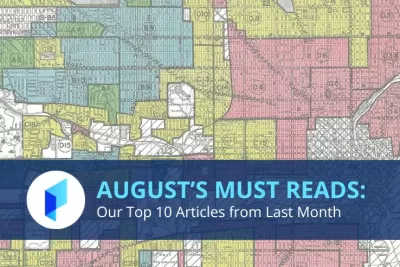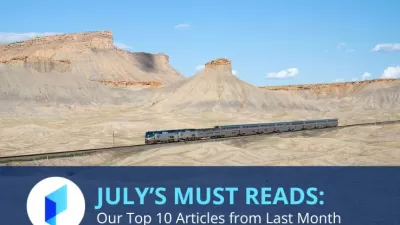Redlining maps, ADU legislation, Project 2025, and more — catch up on Planetizen’s most popular headlines from August.

Features and blogs took center stage on Planetizen last month, capturing eight of our top 10 most popular content slots for August. Those stories included a deep dive into debunking of redlining map myths to important conversations about housing, including Project 2025’s potential impact on housing policy, housing preservation, and the role of ADUs in making homeownership more attainable. Top news headlines included Congress’s move to limit the size of SUVs and trucks and the urgent need to relocate communities at risk from climate change.
Here is the full list:
1. Putting the Myth of the Redlining Maps to Rest
The feature article by Alan Mallach debunks the myth that historical Home Owners’ Loan Corporation (HOLC) maps are a primary cause of racial inequities in today’s Black neighborhoods. Research shows it’s a false narrative that needs to be put to rest, lest we risk investing in strategies that don’t result in any meaningful improvement to the lives of struggling low-income Black families.
2. ADUs as Condos: What Does it Mean for Homeownership?
The article explores how California's AB-1033 law that allows the sale of ADUs as condos could impact homeownership in the state, including making homeownership more attainable, especially in high-cost urban areas where median home prices are out of reach for many.
3. We Must Relocate to Prepare for Climate Change, and We Must Do it Now
This article highlights the critical need to relocate communities at risk from climate change and immediately prepare for its impacts, arguing that proactive measures are essential to protect vulnerable populations and build resilience against increasing climate-related threats.
4. Good As New: The Vital Role of Preservation in Solving the Housing Crisis
The article discusses how historic preservation can play a crucial role in addressing the housing crisis. By repurposing and maintaining existing structures, communities can increase affordable housing options while preserving cultural heritage and reducing environmental impact.
5. Project 2025 and Housing Policy
The blog examines the potential influence of Project 2025, a conservative policy platform from the Heritage Foundation, on housing policy, including potential impacts on affordability and development
6. Pedestrian-Friendly Cities: The Impact of Walkability Grants
This blog discusses how pedestrian-friendly city designs and walkability grants contribute to urban improvement. It highlights the benefits of such grants in enhancing walkability, reducing traffic, and fostering healthier, more vibrant communities.
7. Congress Introduces Bill to Limit Size of SUVs and Trucks
In late August, Congress introduced a bill to limit the size of SUVs and trucks to address safety and environmental concerns. The proposed legislation aims to reduce traffic accidents and lower emissions by setting size restrictions on these vehicles.
8. Book Excerpt: Rochester, New York’s Forgotten Subway
The book excerpt from Lost Subways of America: A Cartographic Guide to the Past, Present, and What Might Have Been by Jake Berman tells the story of Rochester, New York's long-since-shuttered subway system.
9. Book Review: Killed By A Traffic Engineer
Planetizen blogger Michael Lewyn offers his perspective on Killed By A Traffic Engineer by engineering professor Wes Marshall. The book explores the engineering errors that have led to the U.S.’s high traffic fatality rates.
10. Planners Be Nimble, Planners Be Quick
Planning should be methodical and responsive to community needs, but not to the point of inefficiency, Too much planning can be just as harmful as too little, writes Planetizen blogger Todd Litman.
To stay on top of the latest planning news, sign up for Planetizen’s biweekly Newsfeed email newsletter or our once-a-month Planetizen Updates email newsletter.

Trump Administration Could Effectively End Housing Voucher Program
Federal officials are eyeing major cuts to the Section 8 program that helps millions of low-income households pay rent.

Planetizen Federal Action Tracker
A weekly monitor of how Trump’s orders and actions are impacting planners and planning in America.

Ken Jennings Launches Transit Web Series
The Jeopardy champ wants you to ride public transit.

Crime Continues to Drop on Philly, San Francisco Transit Systems
SEPTA and BART both saw significant declines in violent crime in the first quarter of 2025.

How South LA Green Spaces Power Community Health and Hope
Green spaces like South L.A. Wetlands Park are helping South Los Angeles residents promote healthy lifestyles, build community, and advocate for improvements that reflect local needs in historically underserved neighborhoods.

Sacramento Plans ‘Quick-Build’ Road Safety Projects
The city wants to accelerate small-scale safety improvements that use low-cost equipment to make an impact at dangerous intersections.
Urban Design for Planners 1: Software Tools
This six-course series explores essential urban design concepts using open source software and equips planners with the tools they need to participate fully in the urban design process.
Planning for Universal Design
Learn the tools for implementing Universal Design in planning regulations.
Heyer Gruel & Associates PA
Ada County Highway District
Institute for Housing and Urban Development Studies (IHS)
City of Grandview
Harvard GSD Executive Education
Toledo-Lucas County Plan Commissions
Salt Lake City
NYU Wagner Graduate School of Public Service





























